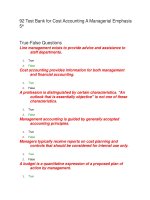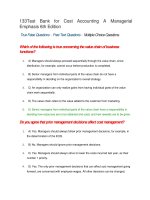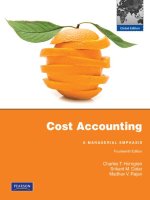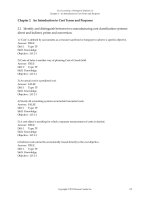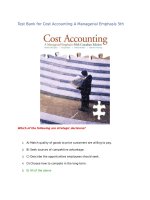Solution manual cost accounting a managerial emphasis 13e by horngren ch03
Bạn đang xem bản rút gọn của tài liệu. Xem và tải ngay bản đầy đủ của tài liệu tại đây (401.66 KB, 43 trang )
To download more slides, ebook, solutions and test bank, visit
CHAPTER 3
COST-VOLUME-PROFIT ANALYSIS
NOTATION USED IN CHAPTER 3 SOLUTIONS
SP:
VCU:
CMU:
FC:
TOI:
Selling price
Variable cost per unit
Contribution margin per unit
Fixed costs
Target operating income
3-1
Cost-volume-profit (CVP) analysis examines the behavior of total revenues, total costs,
and operating income as changes occur in the units sold, selling price, variable cost per unit, or
fixed costs of a product.
3-2
1.
2.
3.
4.
The assumptions underlying the CVP analysis outlined in Chapter 3 are
Changes in the level of revenues and costs arise only because of changes in the number
of product (or service) units sold.
Total costs can be separated into a fixed component that does not vary with the units sold
and a component that is variable with respect to the units sold.
When represented graphically, the behavior of total revenues and total costs are linear
(represented as a straight line) in relation to units sold within a relevant range and time
period.
The selling price, variable cost per unit, and fixed costs are known and constant.
3-3
Operating income is total revenues from operations for the accounting period minus cost
of goods sold and operating costs (excluding income taxes):
Operating income = Total revenues from operations – Costs of goods sold and operating
costs (excluding income taxes
Net income is operating income plus nonoperating revenues (such as interest revenue)
minus nonoperating costs (such as interest cost) minus income taxes. Chapter 3 assumes
nonoperating revenues and nonoperating costs are zero. Thus, Chapter 3 computes net income as:
Net income = Operating income – Income taxes
3-4
Contribution margin is the difference between total revenues and total variable costs.
Contribution margin per unit is the difference between selling price and variable cost per unit.
Contribution-margin percentage is the contribution margin per unit divided by selling price.
3-5
Three methods to express CVP relationships are the equation method, the contribution
margin method, and the graph method. The first two methods are most useful for analyzing
operating income at a few specific levels of sales. The graph method is useful for visualizing the
effect of sales on operating income over a wide range of quantities sold.
3-
To download more slides, ebook, solutions and test bank, visit
3-6
Breakeven analysis denotes the study of the breakeven point, which is often only an
incidental part of the relationship between cost, volume, and profit. Cost-volume-profit
relationship is a more comprehensive term than breakeven analysis.
3-7
CVP certainly is simple, with its assumption of output as the only revenue and cost driver,
and linear revenue and cost relationships. Whether these assumptions make it simplistic depends
on the decision context. In some cases, these assumptions may be sufficiently accurate for CVP
to provide useful insights. The examples in Chapter 3 (the software package context in the text
and the travel agency example in the Problem for Self-Study) illustrate how CVP can provide
such insights. In more complex cases, the basic ideas of simple CVP analysis can be expanded.
3-8
An increase in the income tax rate does not affect the breakeven point. Operating income
at the breakeven point is zero, and no income taxes are paid at this point.
3-9
Sensitivity analysis is a “what-if” technique that managers use to examine how a result
will change if the original predicted data are not achieved or if an underlying assumption
changes. The advent of the electronic spreadsheet has greatly increased the ability to explore the
effect of alternative assumptions at minimal cost. CVP is one of the most widely used software
applications in the management accounting area.
3-10
Examples include:
Manufacturing––substituting a robotic machine for hourly wage workers.
Marketing––changing a sales force compensation plan from a percent of sales dollars to
a fixed salary.
Customer service––hiring a subcontractor to do customer repair visits on an annual
retainer basis rather than a per-visit basis.
3-11
Examples include:
Manufacturing––subcontracting a component to a supplier on a per-unit basis to avoid
purchasing a machine with a high fixed depreciation cost.
Marketing––changing a sales compensation plan from a fixed salary to percent of sales
dollars basis.
Customer service––hiring a subcontractor to do customer service on a per-visit basis
rather than an annual retainer basis.
3-12 Operating leverage describes the effects that fixed costs have on changes in operating
income as changes occur in units sold, and hence, in contribution margin. Knowing the degree of
operating leverage at a given level of sales helps managers calculate the effect of fluctuations in
sales on operating incomes.
3-13 CVP analysis is always conducted for a specified time horizon. One extreme is a very
short-time horizon. For example, some vacation cruises offer deep price discounts for people
who offer to take any cruise on a day’s notice. One day prior to a cruise, most costs are fixed.
The other extreme is several years. Here, a much higher percentage of total costs typically is
variable.
CVP itself is not made any less relevant when the time horizon lengthens. What happens
is that many items classified as fixed in the short run may become variable costs with a longer
time horizon.
3-
To download more slides, ebook, solutions and test bank, visit
3-14 A company with multiple products can compute a breakeven point by assuming there is a
constant sales mix of products at different levels of total revenue.
3-15 Yes, gross margin calculations emphasize the distinction between manufacturing and
nonmanufacturing costs (gross margins are calculated after subtracting fixed manufacturing
costs). Contribution margin calculations emphasize the distinction between fixed and variable
costs. Hence, contribution margin is a more useful concept than gross margin in CVP analysis.
3-16
(10 min.) CVP computations.
a.
b.
c.
d.
Variable
Revenues
Costs
$2,000
$ 500
1,500
2,000
1,000
700
1,500
900
3-17
Fixed
Costs
300
$300
300
300
300
Total
Costs
$ 800
1,800
1,000
1,200
Operating
Income
$1,200
200
0
300
Contribution
Margin
$1,500
500
300
600
Contribution
Margin %
75.0%
25.0%
30.0%
40.0%
(10–15 min.) CVP computations.
1a.
Sales ($30 per unit × 200,000 units)
Variable costs ($25 per unit × 200,000 units)
Contribution margin
$6,000,000
5,000,000
$1,000,000
1b.
Contribution margin (from above)
Fixed costs
Operating income
$1,000,000
800,000
$ 200,000
2a.
Sales (from above)
Variable costs ($16 per unit × 200,000 units)
Contribution margin
$6,000,000
3,200,000
$2,800,000
2b.
Contribution margin
Fixed costs
Operating income
$2,800,000
2,400,000
$ 400,000
3.
Operating income is expected to increase by $200,000 if Ms. Schoenen’s proposal is
accepted.
The management would consider other factors before making the final decision. It is
likely that product quality would improve as a result of using state of the art equipment. Due to
increased automation, probably many workers will have to be laid off. Patel’s management will
have to consider the impact of such an action on employee morale. In addition, the proposal
increases the company’s fixed costs dramatically. This will increase the company’s operating
leverage and risk.
3-18
(35–40 min.) CVP analysis, changing revenues and costs.
3-
To download more slides, ebook, solutions and test bank, visit
1a.
SP
VCU
CMU
FC
= 8% × $1,000 = $80 per ticket
= $35 per ticket
= $80 – $35 = $45 per ticket
= $22,000 a month
Q
=
$22,000
FC
=
$45 per ticket
CMU
= 489 tickets (rounded up)
1b.
Q
=
FC TOI
$22,000 $10,000
=
CMU
$45 per ticket
=
$32,000
$45 per ticket
= 712 tickets (rounded up)
2a.
SP
VCU
CMU
FC
= $80 per ticket
= $29 per ticket
= $80 – $29 = $51 per ticket
= $22,000 a month
Q
=
FC
$22,000
=
CMU
$51 per ticket
= 432 tickets (rounded up)
2b.
Q
=
FC TOI
$22,000 $10,000
=
CMU
$51 per ticket
$32,000
$51 per ticket
= 628 tickets (rounded up)
=
3a.
SP
VCU
CMU
FC
= $48 per ticket
= $29 per ticket
= $48 – $29 = $19 per ticket
= $22,000 a month
Q
=
FC
$22,000
=
CMU
$19 per ticket
= 1,158 tickets (rounded up)
3-
To download more slides, ebook, solutions and test bank, visit
3b.
Q
=
$22,000 $10,000
FC TOI
=
$19 per ticket
CMU
=
$32,000
$19 per ticket
= 1,685 tickets (rounded up)
The reduced commission sizably increases the breakeven point and the number of tickets
required to yield a target operating income of $10,000:
Breakeven point
Attain OI of $10,000
8%
Commission
(Requirement 2)
432
628
Fixed
Commission of $48
1,158
1,685
4a.
The $5 delivery fee can be treated as either an extra source of revenue (as done below) or
as a cost offset. Either approach increases CMU $5:
SP
VCU
CMU
FC
= $53 ($48 + $5) per ticket
= $29 per ticket
= $53 – $29 = $24 per ticket
= $22,000 a month
Q
=
$22,000
FC
=
$24 per ticket
CMU
= 917 tickets (rounded up)
4b.
Q
=
FC TOI
$22,000 $10,000
=
CMU
$24 per ticket
=
$32,000
$24 per ticket
= 1,334 tickets (rounded up)
The $5 delivery fee results in a higher contribution margin which reduces both the breakeven
point and the tickets sold to attain operating income of $10,000.
3-
To download more slides, ebook, solutions and test bank, visit
3-19
(20 min.) CVP exercises.
Orig.
1.
2.
3.
4.
5.
6.
7.
8.
Gstands
Revenues
Variable
Costs
$10,000,000G
10,000,000
10,000,000
10,000,000
10,000,000
10,800,000e
9,200,000g
11,000,000i
10,000,000
$8,000,000G
7,800,000
8,200,000
8,000,000
8,000,000
8,640,000f
7,360,000h
8,800,000j
7,600,000l
Contribution
Margin
$2,000,000
2,200,000a
1,800,000b
2,000,000
2,000,000
2,160,000
1,840,000
2,200,000
2,400,000
Fixed
Costs
$1,800,000G
1,800,000
1,800,000
1,890,000c
1,710,000d
1,800,000
1,800,000
1,980,000k
1,890,000m
Budgeted
Operating
Income
$200,000
400,000
0
110,000
290,000
360,000
40,000
220,000
510,000
for given.
a$2,000,000 × 1.10; b$2,000,000 × 0.90; c$1,800,000 × 1.05; d$1,800,000 × 0.95; e$10,000,000 × 1.08;
f$8,000,000 × 1.08; g$10,000,000 × 0.92; h$8,000,000 × 0.92; i$10,000,000 × 1.10; j$8,000,000 × 1.10;
k$1,800,000 × 1.10; l$8,000,000 × 0.95; m$1,800,000 × 1.05
3-20
(20 min.) CVP exercises.
1a.
[Units sold (Selling price – Variable costs)] – Fixed costs = Operating income
[5,000,000 ($0.50 – $0.30)] – $900,000 = $100,000
1b.
Fixed costs ÷ Contribution margin per unit = Breakeven units
$900,000 ÷ [($0.50 – $0.30)] = 4,500,000 units
Breakeven units × Selling price = Breakeven revenues
4,500,000 units × $0.50 per unit = $2,250,000
or,
Selling price -Variable costs
Contribution margin ratio =
Selling price
$0.50 - $0.30
=
= 0.40
$0.50
Fixed costs ÷ Contribution margin ratio = Breakeven revenues
$900,000 ÷ 0.40 = $2,250,000
2.
5,000,000 ($0.50 – $0.34) – $900,000
= $ (100,000)
3.
[5,000,000 (1.1) ($0.50 – $0.30)] – [$900,000 (1.1)]
= $ 110,000
4.
[5,000,000 (1.4) ($0.40 – $0.27)] – [$900,000 (0.8)]
= $ 190,000
5.
$900,000 (1.1) ÷ ($0.50 – $0.30)
= 4,950,000 units
6.
($900,000 + $20,000) ÷ ($0.55 – $0.30)
= 3,680,000 units
3-
To download more slides, ebook, solutions and test bank, visit
3-21
(10 min.) CVP analysis, income taxes.
1. Monthly fixed costs = $60,000 + $70,000 + $10,000 =
Contribution margin per unit = $26,000 – $22,000 – $500 =
Breakeven units per month =
2. Tax rate
Monthly fixed costs
$140,000
=
=
Contribution margin per unit
$3,500 per car
$140,000
$
3,500
40 cars
40%
Target net income
$63,000
Target net income $63, 000 $63, 000
$105,000
1 - tax rate
(1 0.40)
0.60
Quantity of output units Fixed costs + Target operating income $140, 000 $105, 000
70 cars
required to be sold =
Contribution margin per unit
$3,500
Target operating income =
3-
To download more slides, ebook, solutions and test bank, visit
3-22
(20–25 min.) CVP analysis, income taxes.
1. Variable cost percentage is $3.20 $8.00 = 40%
Let R = Revenues needed to obtain target net income
$105,000
R – 0.40R – $450,000 =
1 0.30
0.60R = $450,000 + $150,000
R = $600,000 0.60
R = $1,000,000
or,
$105,000
Target net income
$450,000 +
1 0.30 = $1,000,000
1 Tax rate
=
Breakeven revenues =
0.60
Contribution margin percentage
Proof:
2.a.
b.
3.
Revenues
Variable costs (at 40%)
Contribution margin
Fixed costs
Operating income
Income taxes (at 30%)
Net income
$1,000,000
400,000
600,000
450,000
150,000
45,000
$ 105,000
Customers needed to earn net income of $105,000:
Total revenues Sales check per customer
$1,000,000 $8 = 125,000 customers
Customers needed to break even:
Contribution margin per customer = $8.00 – $3.20 = $4.80
Breakeven number of customers = Fixed costs Contribution margin per customer
= $450,000 $4.80 per customer
= 93,750 customers
Using the shortcut approach:
Change in net income
= 错误!未指定开关参数。 错误!未指定开关参数。 (1 – Tax
rate)
New net income
= (150,000 – 125,000) $4.80 (1 – 0.30)
= $120,000 0.7 = $84,000
= $84,000 + $105,000 = $189,000
The alternative approach is:
Revenues, 150,000 $8.00
$1,200,000
Variable costs at 40%
480,000
Contribution margin
720,000
Fixed costs
450,000
Operating income
270,000
Income tax at 30%
81,000
Net income
$ 189,000
3-23 (30 min.) CVP analysis, sensitivity analysis
analysis.
3-
To download more slides, ebook, solutions and test bank, visit
1.
SP = $30.00 (1 – 0.30 margin to bookstore)
= $30.00 0.70 = $21.00
VCU = $ 4.00 variable production and marketing cost
3.15 variable author royalty cost (0.15 $21.00)
$ 7.15
CMU = $21.00 – $7.15 = $13.85 per copy
FC = $ 500,000 fixed production and marketing cost
3,000,000 up-front payment to Washington
$3,500,000
Solution Exhibit 3-23A shows the PV graph.
SOLUTION EXHIBIT 3-23A
PV Graph for Media Publishers
$4,000
FC = $3,500,000
CMU = $13.85 per book sold
3,000
Operating income (000’s)
2,000
1,000
0
U n its so ld
100,000
-1,000
200,000
-3,000
$3.5 million
3-
400,000
252,708 units
-2,000
-4,000
300,000
500,000
To download more slides, ebook, solutions and test bank, visit
2a.
FC
Breakeven
=
CMU
number of units
$3,500,000
=
$13.85
= 252,708 copies sold (rounded up)
2b.
Target OI =
FC OI
CMU
$3,500,000 $2,000,000
$13.85
$5,500,000
=
$13.85
= 397,112 copies sold (rounded up)
=
3a. Decreasing the normal bookstore margin to 20% of the listed bookstore price of $30 has the
following effects:
SP
$30.00 (1 – 0.20)
=
=
$30.00 0.80 = $24.00
VCU = $ 4.00 variable production and marketing cost
+ 3.60 variable author royalty cost (0.15 $24.00)
$ 7.60
CMU = $24.00 – $7.60 = $16.40 per copy
FC
Breakeven
=
CMU
number of units
$3,500,000
=
$16.40
= 213,415 copies sold (rounded up)
The breakeven point decreases from 252,708 copies in requirement 2 to 213,415 copies.
3b.
Increasing the listed bookstore price to $40 while keeping the bookstore margin at 30%
has the following effects:
SP
$40.00 (1 – 0.30)
=
=
$40.00 0.70 = $28.00
3-
To download more slides, ebook, solutions and test bank, visit
VCU =$
4.00 variable production and marketing cost
+ 4.20
variable author royalty cost (0.15 $28.00)
$ 8.20
CMU= $28.00 – $8.20 = $19.80 per copy
$3,500,000
Breakeven
=
$19.80
number of units
= 176,768 copies sold (rounded up)
The breakeven point decreases from 252,708 copies in requirement 2 to 176,768 copies.
3c. The answers to requirements 3a and 3b decrease the breakeven point relative to that in
requirement 2 because in each case fixed costs remain the same at $3,500,000 while the
contribution margin per unit increases.
3-24
(10 min.) CVP analysis, margin of safety.
Fixed costs
1.
Breakeven point revenues =
Contribution margin percentage
$600,000
Contribution margin percentage =
= 0.40 or 40%
$1,500,000
Selling price Variable cost per unit
2.
Contribution margin percentage =
Selling price
SP $15
0.40 =
SP
0.40 SP = SP – $15
0.60 SP = $15
SP = $25
3. Breakeven sales in units = Revenues ÷ Selling price = $1,500,000 ÷ $25 = 60,000 units
Margin of safety in units = sales in units – Breakeven sales in units
= 80,000 – 60,000 = 20,000 units
Revenues, 80,000 units $25
Breakeven revenues
Margin of safety
3-
$2,000,000
1,500,000
$ 500,000
To download more slides, ebook, solutions and test bank, visit
3-25
(25 min.) Operating leverage.
1a.
Let Q denote the quantity of carpets sold
Breakeven point under Option 1
$500Q $350Q
= $5,000
$150Q = $5,000
Q = $5,000 $150 = 34 carpets (rounded up)
1b.
2.
Breakeven point under Option 2
$500Q $350Q (0.10 $500Q)
100Q
Q
=
=
=
0
0
0
Operating income under Option 1 = $150Q $5,000
Operating income under Option 2 = $100Q
Find Q such that $150Q $5,000 = $100Q
$50Q = $5,000
Q = $5,000 $50 = 100 carpets
Revenues = $500 × 100 carpets = $50,000
For Q = 100 carpets, operating income under both Option 1 and Option 2 = $10,000
For Q > 100, say, 101 carpets,
Option 1 gives operating income
= ($150 101) $5,000 = $10,150
Option 2 gives operating income
= $100 101
= $10,100
So Color Rugs will prefer Option 1.
For Q < 100, say, 99 carpets,
Option 1 gives operating income
= ($150 99) $5,000 = $9,850
Option 2 gives operating income
= $100 99
= $9,900
So Color Rugs will prefer Option 2.
3.
Contribution margin
Operating income
$150 100
Under Option 1, degree of operating leverage =
= 1.5
$10,000
$100 100
Under Option 2, degree of operating leverage =
= 1.0
$10,000
Degree of operating leverage =
4. The calculations in requirement 3 indicate that when sales are 100 units, a percentage
change in sales and contribution margin will result in 1.5 times that percentage change in
operating income for Option 1, but the same percentage change in operating income for Option 2.
The degree of operating leverage at a given level of sales helps managers calculate the effect of
fluctuations in sales on operating incomes.
3-
To download more slides, ebook, solutions and test bank, visit
3-26
(15 min.) CVP analysis, international cost structure differences.
Variable
Variable
Contribution
Sales price Annual
Manufacturing
Marketing &
to retail
Distribution Cost
Country
Fixed
Cost
Margin
Breakeven
Breakeven
outlets
Costs
per Sweater
per Sweater
Per Unit
Units
Revenues
(1)
(2)
(3)
(4)
(5)=(1)-(3)-(4) (6)=(2) (5)
(6) (1)
Singapore
$32.00 $ 6,500,000
$ 8.00
$11.00
$13.00
500,000 $16,000,000
Thailand
32.00
4,500,000
5.50
11.50
15.00
300,000
9,600,000
United States
32.00
12,000,000
13.00
9.00
10.00
1,200,000
38,400,000
Requirement 1
Thailand has the lowest breakeven point since it has both the lowest fixed costs ($4,500,000) and the
lowest variable cost per unit ($17.00). Hence, for a given selling price, Thailand will always have a
higher operating income (or a lower operating loss) than Singapore or the U.S.
The U.S. breakeven point is 1,200,000 units. Hence, with sales of only 800,000 units, it has an
operating loss of $4,000,000.
3-
Operating Income for
Budgeted Sales of
800,000
Sweaters
(7)=[800,000 (5)] – (2)
$3,900,000
7,500,000
(4,000,000)
Requirement 2
To download more slides, ebook, solutions and test bank, visit
3-27
(30 min.) Sales mix, new and upgrade customers.
1.
SP
VCU
CMU
New
Upgrade
Customers Customers
$210
$120
90
40
120
80
The 60%/40% sales mix implies that, in each bundle, 3 units are sold to new customers and 2
units are sold to upgrade customers.
Contribution margin of the bundle = 3 × $120 + 2 × $80 = $360 + $160 = $520
$14,000,000
Breakeven point in bundles =
= 26,923 bundles
$520
Breakeven point in units is:
Sales to new customers:
26,923 bundles × 3 units per bundle
80,769 units
Sales to upgrade customers: 26,923 bundles × 2 units per bundle
53,846 units
Total number of units to breakeven (rounded)
134,615 units
Alternatively,
Let S = Number of units sold to upgrade customers
1.5S = Number of units sold to new customers
Revenues – Variable costs – Fixed costs = Operating income
[$210 (1.5S) + $120S] – [$90 (1.5S) + $40S] – $14,000,000 = OI
$435S – $175S – $14,000,000 = OI
Breakeven point is 134,616 units when OI = 0 because
$260S
S
1.5S
BEP
= $14,000,000
= 53,846 units sold to upgrade customers (rounded)
= 80,770 units sold to new customers (rounded)
= 134,616 units
Check
Revenues ($210 80,770) + ($120 53,846)
Variable costs ($90 80,770) + ($40 53,846)
Contribution margin
Fixed costs
Operating income (caused by rounding)
3-
$23,423,220
9,423,140
14,000,080
14,000,000
$
80
To download more slides, ebook, solutions and test bank, visit
2.
When 200,000 units are sold, mix is:
Units sold to new customers (60% 200,000)
120,000
Units sold to upgrade customers (40% 200,000) 80,000
Revenues ($210 120,000) + ($120 80,000)
Variable costs ($90 120,000) + ($40 80,000)
Contribution margin
Fixed costs
Operating income
3a.
$34,800,000
14,000,000
20,800,000
14,000,000
$ 6,800,000
At New 50%/Upgrade 50% mix, each bundle contains 1 unit sold to new customer and 1
unit sold to upgrade customer.
Contribution margin of the bundle = 1 $120 + 1 $80 = $120 + $80 = $200
$14,000,000
Breakeven point in bundles =
= 70,000 bundles
$200
Breakeven point in units is:
Sales to new customers:
70,000 bundles × 1 unit per bundle
70,000 units
Sales to upgrade customers:
70,000 bundles × 1 unit per bundle
70,000 units
Total number of units to breakeven
140,000 units
Alternatively,
Let S = Number of units sold to upgrade customers
then S = Number of units sold to new customers
[$210S + $120S] – [$90S + $40S] – $14,000,000 = OI
330S – 130S = $14,000,000
200S = $14,000,000
S =70,000 units sold to upgrade customers
S = 70,000 units sold to new customers
BEP
= 140,000 units
Check
Revenues ($210 70,000) + ($120 70,000)
$23,100,000
Variable costs ($90 70,000) + ($40 70,000)
9,100,000
Contribution margin
14,000,000
Fixed costs
14,000,000
Operating income
$
0
3b.
At New 90%/ Upgrade 10% mix, each bundle contains 9 units sold to new customers and 1
unit sold to upgrade customers.
Contribution margin of the bundle = 9 $120 + 1 $80 = $1,080 + $80 = $1,160
$14,000,000
Breakeven point in bundles =
= 12,069 bundles (rounded)
$1,160
Breakeven point in units is:
Sales to new customers:
12,069 bundles × 9 units per bundle
108,621 units
Sales to upgrade customers:
12,069 bundles × 1 unit per bundle
12,069 units
Total number of units to breakeven
120,690 units
3-
To download more slides, ebook, solutions and test bank, visit
Alternatively,
Let S = Number of units sold to upgrade customers
then 9S= Number of units sold to new customers
[$210 (9S) + $120S] – [$90 (9S) + $40S] – $14,000,000 = OI
2,010S – 850S = $14,000,000
1,160S = $14,000,000
S =12,069 units sold to upgrade customers (rounded up)
9S =108,621 units sold to new customers (rounded up)
120,690 units
Check
Revenues ($210 108,621) + ($120 12,069)
Variable costs ($90 108,621) + ($40 12,069)
Contribution margin
Fixed costs
Operating income (caused by rounding)
$24,258,690
10,258,650
14,000,040
14,000,000
$
40
3c. As Zapo increases its percentage of new customers, which have a higher contribution
margin per unit than upgrade customers, the number of units required to break even decreases:
Requirement 3(a)
Requirement 1
Requirement 3(b)
3-28
(20 min.) CVP analysis, multiple cost drivers.
1a.
Operating
income
1b.
Operating
income
2.
New
Upgrade
Breakeven
Customers Customers
Point
50%
50%
140,000
60
40
134,616
90
10
120,690
Cost of picture Quantity of Cost of
Fixed
Number of
= Revenues
shipment shipments costs
frames
picture
frames
= ($45 40,000) ($30 40,000) ($60 1,000) $240,000
= $1,800,000 $1,200,000 $60,000 $240,000 = $300,000
= ($45 40,000) ($30 40,000) ($60 800) $240,000 = $312,000
Denote the number of picture frames sold by Q, then
$45Q $30Q – (500 $60) $240,000 = 0
$15Q = $30,000 + $240,000 = $270,000
Q = $270,000 $15 = 18,000 picture frames
3.
Suppose Susan had 1,000 shipments.
$45Q $30Q (1,000 $60) $240,000 = 0
15Q = $300,000
Q = 20,000 picture frames
The breakeven point is not unique because there are two cost drivers—quantity
of picture frames and number of shipments. Various combinations of the two cost
drivers can yield zero operating income.
3-
To download more slides, ebook, solutions and test bank, visit
3-29 (25 mins) CVP, Not for profit.
1.
Contributions
Fixed costs
Cash available to purchase land
Divided by cost per acre to purchase land
Acres of land SG can purchase
$19,000,000
1,000,000
$18,000,000
÷3,000
6,000 acres
2.
Contributions ($19,000,000 – $5,000,000)
Fixed costs
Cash available to purchase land
Divided by cost per acre to purchase land ($3,000 – $1,000)
Acres of land SG can purchase
$14,000,000
1,000,000
$13,000,000
÷2,000
6,500 acres
On financial considerations alone, SG should take the subsidy because it can purchase
500 more acres (6,500 acres – 6,000 acres).
3.
Let the decrease in contributions be $ x .
Cash available to purchase land = $19,000,000 – $ x – $1,000,000
Cost to purchase land = $3,000 – $1,000 = $2,000
To purchase 6,000 acres, we solve the following equation for x .
19,000,000 x 1,000,000
6,000
2,000
18,000,000 x 6,000 2,000
18,000,000 x 12,000,000
x $6,000,000
SG will be indifferent between taking the government subsidy or not if contributions
decrease by $6,000,000.
3-
To download more slides, ebook, solutions and test bank, visit
3-30
(15 min.) Contribution margin, decision making.
1.
Revenues
Deduct variable costs:
Cost of goods sold
Sales commissions
Other operating costs
Contribution margin
$500,000
$200,000
50,000
40,000
290,000
$210,000
$210,000
= 42%
$500,000
2.
Contribution margin percentage =
3.
Incremental revenue (20% × $500,000) = $100,000
Incremental contribution margin
(42% × $100,000)
Incremental fixed costs (advertising)
Incremental operating income
$42,000
10,000
$32,000
If Mr. Schmidt spends $10,000 more on advertising, the operating income will increase
by $32,000, converting an operating loss of $10,000 to an operating income of $22,000.
Proof (Optional):
Revenues (120% × $500,000)
Cost of goods sold (40% of sales)
Gross margin
Operating costs:
Salaries and wages
Sales commissions (10% of sales)
Depreciation of equipment and fixtures
Store rent
Advertising
Other operating costs:
$40,000
Variable (
× $600,000)
$500,000
Fixed
Operating income
3-
$600,000
240,000
360,000
$150,000
60,000
12,000
48,000
10,000
48,000
10,000
338,000
$ 22,000
To download more slides, ebook, solutions and test bank, visit
3-31
(20 min.) Contribution margin, gross margin and margin of safety.
1.
Mirabella Cosmetics
Operating Income Statement, June 2008
Units sold
Revenues
Variable costs
Variable manufacturing costs
Variable marketing costs
Total variable costs
Contribution margin
Fixed costs
Fixed manufacturing costs
Fixed marketing & administration costs
Total fixed costs
Operating income
2.
10,000
$100,000
$ 55,000
5,000
60,000
40,000
$ 20,000
10,000
30,000
$ 10,000
$40,000
$4 per unit
10,000 units
Fixed costs
$30, 000
Breakeven quantity =
7,500 units
Contribution margin per unit $4 per unit
Revenues
$100, 000
Selling price =
$10 per unit
Units sold 10,000 units
Breakeven revenues = 7,500 units $10 per unit = $75,000
Contribution margin per unit =
Alternatively,
Contribution margin percentage =
Breakeven revenues =
Contribution margin $40, 000
40%
Revenues
$100, 000
Fixed costs
$30, 000
$75, 000
Contribution margin percentage
0.40
3. Margin of safety (in units) = Units sold – Breakeven quantity
= 10,000 units – 7,500 units = 2,500 units
4.
Units sold
8,000
Revenues (Units sold Selling price = 8,000 $10)
Contribution margin (Revenues CM percentage = $80,000 40%)
$32,000
Fixed costs
30,000
Operating income
Taxes (30% $2,000)
3-
$80,000
2,000
600
To download more slides, ebook, solutions and test bank, visit
Net income
$ 1,400
3-
To download more slides, ebook, solutions and test bank, visit
3-32 (30 min.) Uncertainty and expected costs.
1. Monthly Number of Orders
300,000
400,000
500,000
600,000
700,000
Cost of Current System
$1,000,000 + $40(300,000) = $13,000,000
$1,000,000 + $40(400,000) = $17,000,000
$1,000,000 + $40(500,000) = $21,000,000
$1,000,000 + $40(600,000) = $25,000,000
$1,000,000 + $40(700,000) = $29,000,000
Monthly Number of Orders
300,000
400,000
500,000
600,000
700,000
Cost of Partially Automated System
$5,000,000 + $30(300,000) = $14,000,000
$5,000,000 + $30(400,000) = $17,000,000
$5,000,000 + $30(500,000) = $20,000,000
$5,000,000 + $30(600,000) = $23,000,000
$5,000,000 + $30(700,000) = $26,000,000
Monthly Number of Orders
300,000
400,000
500,000
600,000
700,000
Cost of Fully Automated System
$10,000,000 + $20(300,000) = $16,000,000
$10,000,000 + $20(400,000) = $18,000,000
$10,000,000 + $20(500,000) = $20,000,000
$10,000,000 + $20(600,000) = $22,000,000
$10,000,000 + $20(700,000) = $24,000,000
2. Current System Expected Cost:
$13,000,000 × 0.1 = $ 1,300,000
17,000,000 × 0.25 = 4,250,000
21,000,000 × 0.40 = 8,400,000
25,000,000 × 0.15 = 3,750,000
29,000,000 × 0.10 = 2,900,000
$ 20,600,000
Partially Automated System Expected Cost:
$14,000,000 × 0.1 = $ 1 ,400,000
17,000,000 × 0.25 = 4,250,000
20,000,000 × 0.40 = 8,000,000
23,000,000 × 0.15 = 3,450,000
26,000,000 × 0.1 = 2,600,000
$19,700,000
Fully Automated System Expected Cost:
$16,000,000 × 0.1 = $ 1,600,000
18,000,000 × 0.25 = 4,500,000
20,000,000 × 0.40 = 8,000,000
22,000,000 × 0.15 = 3,300,000
24,000,000 × 0.10 = 2,400,000
$19,800,000
3-
To download more slides, ebook, solutions and test bank, visit
3. Dawmart should consider the impact of the different systems on its relationship with suppliers.
The interface with Dawmart’s system may require that suppliers also update their systems. This
could cause some suppliers to raise the cost of their merchandise. It could force other suppliers to
drop out of Dawmart’s supply chain because the cost of the system change would be prohibitive.
Dawmart may also want to consider other factors such as the reliability of different systems and
the effect on employee morale if employees have to be laid off as it automates its systems.
3-33
(15–20 min.) CVP analysis, service firm
firm.
1.
Revenue per package
Variable cost per package
Contribution margin per package
$4,000
3,600
$ 400
Breakeven (units) = Fixed costs ÷ Contribution margin per package
$480,000
=
= 1,200 tour packages
$400 per package
2.
Contribution margin ratio =
Contribution margin per package
$400
=
= 10%
Selling price
$4,000
Revenue to achieve target income = (Fixed costs + target OI) ÷ Contribution margin ratio
$480,000 $100,000
=
= $5,800,000, or
0.10
$480,000 $100,000
Number of tour packages to earn $100,000 operating income:
1,450 tour packages
$400
Revenues to earn $100,000 OI = 1,450 tour packages × $4,000 = $5,800,000.
3.
Fixed costs = $480,000 + $24,000 = $504,000
Breakeven (units) =
Fixed costs
Contribution margin per unit
Fixed costs
Breakeven (units)
$504,000
=
= $420 per tour package
1,200 tour packages
Contribution margin per unit =
Desired variable cost per tour package = $4,000 – $420 = $3,580
Because the current variable cost per unit is $3,600, the unit variable cost will need to be reduced
by $20 to achieve the breakeven point calculated in requirement 1.
Alternate Method: If fixed cost increases by $24,000, then total variable costs must be reduced
by $24,000 to keep the breakeven point of 1,200 tour packages.
Therefore, the variable cost per unit reduction = $24,000 ÷ 1,200 = $20 per tour package
3-
To download more slides, ebook, solutions and test bank, visit
3-34
(30 min.) CVP, target income, service firm.
1.
Revenue per child
Variable costs per child
Contribution margin per child
Breakeven quantity =
=
2.
Target quantity =
=
3.
$600
200
$400
Fixed costs
Contribution margin per child
$5,600
= 14 children
$400
Fixed costs Target operating income
Contribution margin per child
$5,600 $10,400
= 40 children
$400
Increase in rent ($3,000 – $2,000)
Field trips
Total increase in fixed costs
Divide by the number of children enrolled
Increase in fee per child
$1,000
1,000
$2,000
÷ 40
$ 50
Therefore, the fee per child will increase from $600 to $650.
Alternatively,
New contribution margin per child =
$5,600 $2,000 $10,400
= $450
40
New fee per child = Variable costs per child + New contribution margin per child
= $200 + $450 = $650
3-
To download more slides, ebook, solutions and test bank, visit
3-35
(20–25 min.) CVP analysis.
1.
Selling price
Variable costs per unit:
Purchase price
$10.00
Shipping and handling
2.00
Contribution margin per unit (CMU)
$16.00
12.00
$ 4.00
Fixed costs
$600,000
=
= 150,000 units
Contr. margin per unit
$4.00
Margin of safety (units) = 200,000 – 150,000 = 50,000 units
Breakeven point in units =
2.
Since Galaxy is operating above the breakeven point, any incremental contribution
margin will increase operating income dollar for dollar.
Increase in units sales = 10% × 200,000 = 20,000
Incremental contribution margin = $4 × 20,000 = $80,000
Therefore, the increase in operating income will be equal to $80,000.
Galaxy’s operating income in 2008 would be $200,000 + $80,000 = $280,000.
3.
Selling price
Variable costs:
Purchase price $10 × 130%
Shipping and handling
Contribution margin per unit
Target sales in units =
$16.00
$13.00
2.00
FC TOI
$600,000 $200,000
=
= 800,000 units
CMU
$1
Target sales in dollars = $16 × 800,000 = $12,800,000
3-
15.00
$ 1.00
To download more slides, ebook, solutions and test bank, visit
3-36
(30–40 min.) CVP analysis, income taxes.
1.
Revenues – Variable costs – Fixed costs =
Target net income
1 Tax rate
Let X = Net income for 2008
20,000($25.00) – 20,000($13.75) – $135,000 =
$500,000 – $275,000 – $135,000 =
X
1 0.40
X
0.60
$300,000 – $165,000 – $81,000 = X
X = $54,000
Alternatively,
Operating income = Revenues – Variable costs – Fixed costs
= $500,000 – $275,000 – $135,000 = $90,000
Income taxes = 0.40 × $90,000 = $36,000
Net income = Operating income – Income taxes
= $90,000 – $36,000 = $54,000
2.
Let Q = Number of units to break even
$25.00Q – $13.75Q – $135,000 = 0
Q = $135,000 $11.25 = 12,000 units
3.
Let X = Net income for 2009
22,000($25.00) – 22,000($13.75) – ($135,000 + $11,250)
=
$550,000 – $302,500 – $146,250
=
$101,250
=
X
1 0.40
X
0.60
X
0.60
X = $60,750
4.
Let Q = Number of units to break even with new fixed costs of $146,250
$25.00Q – $13.75Q – $146,250
Q = $146,250 $11.25
Breakeven revenues = 13,000 $25.00
5.
= 0
= 13,000 units
= $325,000
Let S = Required sales units to equal 2008 net income
$25.00S – $13.75S – $146,250 =
$54,000
0.60
$11.25S = $236,250
S = 21,000 units
Revenues = 21,000 units $25 = $525,000
6.
Let A = Amount spent for advertising in 2009
$550,000 – $302,500 – ($135,000 + A) =
$60,000
0.60
$550,000 – $302,500 – $135,000 – A = $100,000
$550,000 – $537,500 = A
A = $12,500
3-


